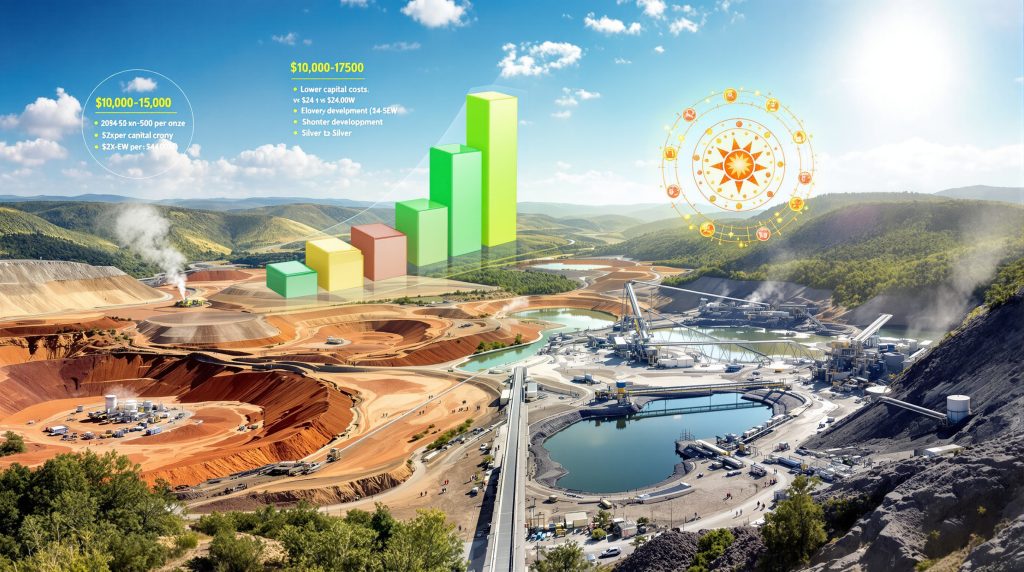Understanding the Foundation of Tailings Reprocessing
What Are Mining Tailings and Why Do They Matter?
Mining tailings represent the processed mineral waste that remains after extraction operations, yet these materials frequently contain significant quantities of recoverable valuable resources. Historical mining techniques often left substantial amounts of precious metals and critical minerals within these waste streams, creating enormous untapped potential across global mining regions.
The scale of this opportunity proves remarkable, with industry estimates suggesting that millions of tonnes of tailings worldwide contain economically viable concentrations of gold, platinum, rare earth elements, and other strategic materials. As primary ore grades continue declining across established mining districts, companies increasingly recognise tailings retreatment in modern mining as viable secondary resources rather than environmental liabilities.
The Evolution from Waste to Resource
Technological advances now enable economic extraction from materials previously considered unviable for processing. Enhanced metallurgical techniques, including glycine leaching systems and improved flotation technologies, can recover metals from fine particle distributions that older methods couldn't effectively capture.
Changing market dynamics simultaneously drive demand for secondary mineral sources, particularly as supply chain security becomes a strategic priority for technology sectors. Furthermore, regulatory pressures transform environmental liabilities into business opportunities, with governments increasingly requiring comprehensive rehabilitation plans that can generate revenue streams.
What Economic Benefits Drive Tailings Retreatment Adoption?
Capital Efficiency Advantages
Tailings retreatment operations demonstrate significant capital efficiency compared to greenfield mining developments. While traditional mining projects typically require $25,000 to $40,000 in capital expenditure per ounce of productive capacity, tailings reprocessing facilities often achieve similar output with investment levels between $10,000 and $15,000 per ounce.
Infrastructure reuse opportunities substantially reduce startup costs, as existing roads, power connections, water systems, and processing facilities can often be adapted for retreatment operations. Consequently, development timelines also accelerate dramatically, with most tailings projects achieving production within 12 to 24 months compared to the 5+ year timelines typical for traditional mining ventures.
Operational Cost Structures and Profit Margins
Processing costs per tonne of material present compelling economics for tailings operations. While conventional mining typically faces processing costs ranging from $30 to $200 per tonne depending on ore complexity, tailings retreatment often achieves similar recovery rates at costs between $1 to $2 per tonne due to the pre-crushed nature of the material.
Risk reduction through predictable grade consistency provides additional financial advantages. Unlike exploration-stage projects with uncertain resource estimates, tailings deposits offer well-characterised grade distributions based on historical production data and modern analytical techniques.
Table: Economic Comparison – Tailings Retreatment vs. Traditional Mining
| Metric | Tailings Retreatment | Traditional Mining |
|---|---|---|
| Capital Cost per Ounce | $10,000-15,000 | $25,000-40,000 |
| Processing Cost per Tonne | $1-2 | $30-200 |
| Development Timeline | 12-24 months | 5+ years |
| Payback Period | 2-4 years | 7-10 years |
How Do Modern Technologies Enable Effective Tailings Processing?
Advanced Extraction Methodologies
Heap leaching applications have proven particularly effective for low-grade tailings materials containing gold and copper. This technique involves stacking processed waste material and applying chemical solutions that dissolve target metals, which are then collected and concentrated through established recovery systems.
In addition, flotation technology improvements enable recovery from fine particle distributions that previously presented significant technical challenges. Modern flotation cells can process materials with particle sizes below 50 microns, capturing values that older equipment couldn't effectively separate from waste rock.
Chemical processing innovations include glycine-based leaching systems that offer environmental advantages over traditional cyanide processes while maintaining high recovery rates for precious metals. These systems demonstrate particular effectiveness in processing oxidised materials common in aged tailings deposits.
Process Optimisation and Recovery Enhancement
Solvent extraction-electrowinning (SX-EW) implementation strategies have revolutionised copper recovery from tailings materials. This two-stage process first extracts copper ions into an organic solution, then uses electrochemical methods to produce high-purity cathode copper suitable for industrial applications.
Furthermore, multi-stage processing maximises resource extraction by targeting different mineral phases sequentially. Initial gravity separation may concentrate heavy minerals, followed by flotation to recover sulfide minerals, and finally chemical leaching to extract remaining values from oxide materials.
Quality control systems ensure consistent output grades through continuous monitoring of feed characteristics, reagent consumption, and product specifications. Automated sampling and analysis equipment provides real-time data enabling rapid process adjustments to maintain optimal recovery rates.
What Environmental and Social Advantages Result from Tailings Retreatment?
Legacy Contamination Remediation
Heavy metal removal from historic tailings deposits addresses decades of environmental contamination while generating revenue streams. Processing operations extract lead, zinc, copper, and other potentially harmful elements that might otherwise leach into surrounding ecosystems over extended timeframes.
Moreover, acid drainage mitigation occurs through material processing that removes sulfide minerals responsible for generating acidic conditions. By extracting these problematic minerals during retreatment, companies eliminate long-term acid generation potential while recovering valuable metals through effective waste management solutions.
Groundwater protection benefits from contamination source elimination as processing removes the materials most likely to create environmental problems. Well-designed retreatment operations can reduce groundwater contamination risk by 60-80% according to environmental monitoring data from established projects.
Land Rehabilitation and Repurposing Opportunities
Soil stabilisation techniques for post-processing areas create opportunities for diverse land uses including agriculture, renewable energy development, and commercial construction. Modern cover systems incorporating brown cover (topsoil) or grey cover (rock) materials provide long-term stability while supporting vegetation establishment.
Agricultural potential assessment indicates that rehabilitated mining land can support various crop types, though achieving commercial viability requires 500-600mm soil depth and careful attention to soil microbiology. Data shows that stabilisation typically requires 5-7 years before rehabilitated land can sustain healthy agricultural root systems.
Mining companies report creating hundreds of direct and indirect jobs through retreatment operations, while generating millions in annual profits that support community development trusts and local supplier networks.
How Does Tailings Retreatment Support ESG Compliance?
Environmental Stewardship Metrics
Carbon footprint reduction compared to primary mining results from shorter transportation distances, existing infrastructure utilisation, and elimination of extensive overburden removal operations. Studies indicate tailings retreatment can reduce carbon emissions by 40-60% compared to equivalent metal production from greenfield operations, contributing significantly to mining decarbonisation benefits.
Waste stream minimisation through circular economy principles transforms historical waste into productive resources while reducing the volume of materials requiring long-term storage. This approach aligns with regulatory trends toward zero waste mining concepts gaining acceptance across jurisdictions.
However, water usage optimisation in processing operations often achieves significant efficiency gains through closed-loop systems and advanced water treatment technologies. Many tailings retreatment facilities operate with 30-50% less fresh water consumption than comparable primary mining operations.
Social Licence and Community Relations
Employment generation in established mining communities provides economic continuity as traditional mining operations mature or conclude. One major retreatment initiative created 500 direct and indirect jobs while engaging 25 local suppliers and generating R130-million in yearly profits for community development programmes.
Community benefit sharing through development trusts channels portions of retreatment revenues into education, healthcare, and economic development initiatives. Consequently, these programmes help sustain communities beyond mining by building capacity for alternative economic activities.
What Strategic Role Does Retreatment Play in Critical Mineral Supply?
Supply Chain Security Enhancement
Domestic resource development reduces import dependencies for strategic materials including rare earth elements, lithium, and platinum group metals. Government policies increasingly recognise secondary recovery as essential for maintaining technological competitiveness and reducing geopolitical supply risks.
Critical mineral recovery supports technology sectors requiring reliable sources of battery materials, permanent magnet components, and catalyst materials. Tailings retreatment in modern mining can provide 15-25% of certain critical mineral requirements according to geological survey assessments.
For instance, supply diversification mitigates geopolitical risks by developing alternative sources within politically stable jurisdictions. This proves particularly valuable for materials where primary production concentrates in regions subject to trade restrictions or political instability.
Future-Proofing Mining Operations
Mine life extension through waste resource utilisation can add 5-15 years to operational lifespans while maintaining employment and economic activity. This approach proves especially valuable in mature mining districts where primary resources approach depletion, contributing to comprehensive mining sustainability strategies.
Operational flexibility during commodity price fluctuations allows companies to adjust production between primary mining and tailings processing based on market conditions. Lower operating costs for tailings operations provide buffer capacity during price downturns.
Which Global Examples Demonstrate Successful Implementation?
Case Study Analysis: Leading Retreatment Operations
Production statistics from major tailings processing facilities demonstrate the sector's growing significance. Operations near Klerksdorp, South Africa process tailings across 1,800 hectares, with plans to consolidate materials into smaller, engineered facilities covering only 900 hectares, thereby freeing land for alternative uses.
Financial performance metrics indicate strong profitability, with established operations generating millions in annual revenue while supporting hundreds of jobs. These facilities often achieve payback periods of 2-4 years compared to traditional mining's 7-10 year typical timeframes.
Furthermore, environmental improvement outcomes include significant reductions in dust generation, groundwater contamination risks, and long-term maintenance requirements. Properly designed retreatment operations can eliminate 80-90% of ongoing environmental management costs associated with abandoned tailings facilities.
Lessons Learned and Best Practices
Critical success factors include comprehensive resource characterisation, appropriate technology selection, and strong stakeholder engagement from project initiation. Successful operations typically invest 6-12 months in detailed feasibility studies before committing to full-scale development.
Common challenges involve managing variable feed grades, optimising recovery circuits for complex mineralogy, and coordinating environmental approvals across multiple regulatory agencies. However, mitigation strategies focus on robust process control systems and proactive regulatory engagement.
How Do Companies Evaluate Tailings Retreatment Opportunities?
Technical Feasibility Assessment
Mineralogical characterisation requirements include detailed analysis of particle size distribution, mineral associations, and deportment studies indicating how target metals occur within the tailings matrix. This analysis typically requires 3-6 months of sampling and laboratory testing.
Grade distribution analysis examines spatial variability across tailings deposits to optimise mining sequences and processing strategies. Modern geostatistical techniques enable accurate resource estimation even in historically poorly documented deposits.
Processing technology selection criteria consider feed characteristics, target recovery rates, environmental constraints, and capital/operating cost projections. Consequently, pilot-scale testing often proves essential for validating process design assumptions.
Economic Viability Modelling
Cash flow projection methodologies incorporate commodity price forecasting, operating cost escalation, and capital expenditure scheduling over project lifespans typically ranging 10-20 years. Sensitivity analysis examines project viability across various price scenarios.
Risk assessment frameworks evaluate technical, environmental, regulatory, and market risks that could impact project economics. Monte Carlo simulation techniques help quantify uncertainty ranges around base-case financial projections.
Tailings retreatment viability depends on four key factors: contained metal grades exceeding processing costs, suitable extraction technology availability, favourable regulatory environment, and market demand for recovered materials.
What Future Developments Will Shape Tailings Retreatment?
Technological Innovation Trends
Artificial intelligence applications in grade optimisation use machine learning algorithms to predict optimal processing conditions based on real-time feed characteristics. These systems can improve recovery rates by 3-8% while reducing reagent consumption.
Automated processing system developments incorporate robotic sampling, autonomous equipment operation, and predictive maintenance programmes. Full automation can reduce operating costs by 15-25% while improving safety performance, supporting advances in mine reclamation innovation.
Enhanced recovery technique research focuses on bio-leaching processes using specialised bacteria to extract metals from low-grade materials. These biological approaches offer environmental advantages while potentially accessing previously unrecoverable resources.
Regulatory and Market Evolution
Stricter tailings management requirements following major facility failures worldwide drive retreatment adoption as companies seek to eliminate long-term liability exposure. The Global Industry Standard on Tailings Management (GISTM) emphasises alternative approaches including retreatment and underground storage.
Carbon pricing mechanisms increasingly favour secondary resource development over primary mining due to lower greenhouse gas emissions. Carbon credit opportunities may provide additional revenue streams for retreatment operations.
Critical mineral strategies promote domestic processing capabilities, with government incentives supporting projects that reduce import dependencies for strategic materials. These policies particularly benefit retreatment operations recovering battery metals and rare earth elements.
Frequently Asked Questions About Tailings Retreatment
Is tailings retreatment economically viable for all mining operations?
Economic feasibility depends on several critical factors including contained metal grades, processing complexity, regulatory environment, and market conditions. Generally, tailings containing gold grades above 0.3 grams per tonne or copper grades exceeding 0.15% warrant detailed evaluation, though specific thresholds vary based on operational conditions.
Minimum profitability thresholds also consider processing costs, which typically range $1-3 per tonne for tailings compared to $15-50 per tonne for primary ores. Market conditions affecting commodity prices, regulatory fees, and financing costs significantly influence project viability.
What environmental risks are associated with tailings reprocessing?
Potential contamination concerns during processing include dust generation, water contamination, and soil disturbance, though these risks generally prove lower than those associated with primary mining operations. Proper facility design incorporates lined process areas, dust suppression systems, and water treatment infrastructure to minimise environmental impact.
Mitigation strategies require comprehensive environmental management plans, regular monitoring programmes, and emergency response procedures. Long-term environmental benefits typically outweigh short-term risks, particularly when operations eliminate ongoing contamination sources.
How does retreatment affect local communities?
Employment opportunities include both direct positions in processing operations and indirect jobs in supporting industries such as transportation, maintenance, and supply services. Successful retreatment operations often create 2-3 indirect jobs for each direct position.
Environmental improvements include reduced dust exposure, groundwater protection, and elimination of unstable tailings facilities that pose long-term risks. Health considerations generally favour retreatment operations over leaving tailings in place, particularly in areas with acid drainage potential.
Community consultation mechanisms ensure local stakeholders participate in project planning, environmental monitoring, and benefit distribution decisions. Benefit-sharing programmes typically allocate 5-15% of project revenues to community development initiatives.
Implementation Roadmap for Mining Companies
Phase 1: Opportunity Assessment
Tailings inventory and characterisation begins with comprehensive mapping of existing facilities, historical production records, and preliminary sampling programmes. This phase typically requires 3-6 months and establishes the foundation for detailed technical evaluation.
Key activities include:
• Facility location mapping using GPS and aerial photography
• Historical data compilation from production records and previous studies
• Preliminary sampling programmes to assess grade distributions
• Stakeholder identification including regulatory agencies and community groups
Preliminary economic evaluation examines potential project scenarios using order-of-magnitude cost estimates and conservative recovery assumptions. This analysis helps prioritise opportunities for detailed investigation.
Phase 2: Detailed Feasibility Study
Comprehensive technical analysis includes extensive drilling programmes, metallurgical testing, and process design optimisation. This phase typically spans 12-18 months and provides the detailed information required for investment decisions.
Critical components include:
• Resource estimation using industry-standard techniques
• Metallurgical test work including pilot-scale processing trials
• Process design incorporating optimal technology selection
• Infrastructure assessment evaluating existing facilities and required upgrades
Environmental impact assessment addresses all potential environmental effects through baseline studies, impact modelling, and mitigation measure development. Regulatory approval processes often run parallel to technical studies to minimise project development timelines.
Phase 3: Project Development and Execution
Technology selection and procurement involves detailed vendor evaluations, equipment specifications, and delivery scheduling. Long-lead items such as specialised processing equipment may require 6-12 months delivery timeframes.
Infrastructure development planning coordinates construction activities including:
• Site preparation and access road construction
• Utility connections for power, water, and communications
• Processing facility construction incorporating environmental controls
• Tailings management systems for processed materials
Performance monitoring system implementation ensures optimal operational efficiency through real-time data collection, automated reporting, and continuous improvement programmes. These systems typically achieve full operational capability within 6-12 months of commissioning.
Furthermore, tailings retreatment in modern mining represents a transformative approach that addresses environmental concerns while creating substantial economic value, positioning the mining industry for a more sustainable and profitable future.
The industry continues evolving toward recognising tailings retreatment as a core component of modern mining operations. Additionally, comprehensive guides on transforming mining waste provide valuable insights for companies considering retreatment opportunities within their operational portfolios.
Ready to Capitalise on the Next Mining Innovation?
Tailings retreatment represents one of the most significant opportunities in modern mining, yet identifying the companies pioneering these profitable transformations requires cutting-edge market intelligence. Discovery Alert's proprietary Discovery IQ model delivers instant notifications about breakthrough announcements from ASX-listed mining companies, including those advancing tailings processing technologies and achieving remarkable recovery results that could generate substantial returns.




